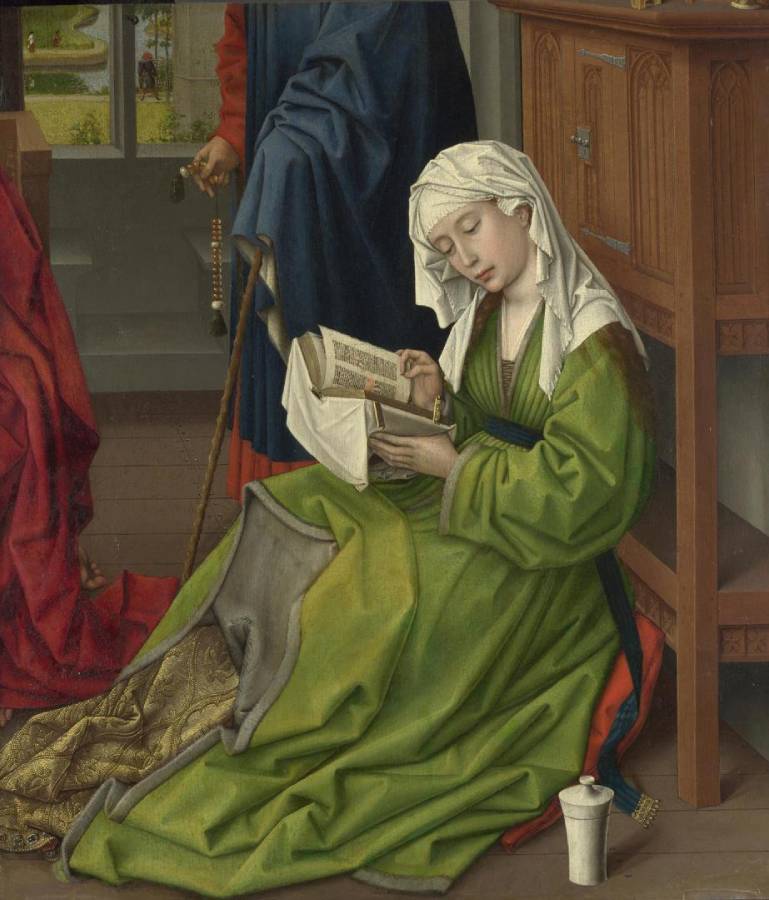Van der Weyden, Rogier (c.1399-1464)
The Magdalen Reading
c.1435
Oil on mahogany, transferred from another panel, 62.2 × 54.4 cm
National Gallery, London
A young lady in an extravagant green dress sits on the floor, reading. Although she wears fifteenth-century clothing and is in a medieval room, she is a biblical figure: Saint Mary Magdalene. Her figure forms a semi-circle, with her head and legs curving around her bent knees, emphasising her absorption in her book. This use of geometric harmonies to express feeling is typical of Rogier van der Weyden.
This is a fragment of a larger painting, and you can see parts of other figures: a man leaning on a stick behind Mary and another kneeling to the left, his toes poking out from under his voluminous robe. She sits on a red cushion and leans against a carved wooden cabinet. Her overdress is lined with grey fur and cinched in tight around her waist. It falls in bulky folds around her legs, and is turned back so that we can see her cloth of gold underdress. Her loose hair is covered with a white veil, fluted at the edges and tucked behind her ears; this is not the fashionable headdress worn by contemporary ladies – as seen in A Woman by Robert Campin – but something more suited to a figure from biblical times.
She seems to be reading a Bible, written in two columns with large red and blue initials marking different chapters. It is a luxurious volume: the fore-edges and clasps are gilded and it is covered with a white chemise, a kind of book jacket which was wrapped around special books to protect them. Look closely and you can see the stitching along the upper edge of the binding and the minuscule cord bookmarks wrapped around the pipe. The saint’s attribute, the pot containing the oil she used to anoint Christ’s feet, stands on the floor beside her, casting a strong shadow. By the Middle Ages Mary Magdalene had become a conflation of various biblical stories. The sinful woman who had washed Christ’s feet with her tears and anointed them with oil (Luke 7: 36–38) was combined with Mary of Bethany, sister of Lazarus, who ’seated herself at the Lord’s feet and listened to his word‘ (Luke 10: 38–42). She was understood as an example of the contemplative life.
Through a window at the back of the room we can see a river winding lazily past, and people walking its banks. On the near bank an archer in a short purple robe and a red hat aims a crossbow. On the far side a man in red and black is followed by a woman in a black hat, white overdress kilted up over a red underdress; you can see her reflection in the water.
This painting was originally the lower right corner of what must have been a large altarpiece of the Virgin and Child with saints, painted for a church in Brussels. It was possibly one of van der Weyden’s first commissions after he settled there in 1435. A fifteenth-century sketch of it (now in the Nationalmuseum, Stockholm) allows us to reconstruct what it originally looked like. The man with the stick and the amber beads behind Mary is Saint Joseph; his head survives in the Fundaçāo Calouste Gulbenkian, Lisbon (along with the head of another female saint, perhaps Saint Catherine). The Virgin and Child would have been seated in the centre, with a youthful Saint John the Evangelist kneeling to their left – it is his toes and parts of his robe that survive in our painting. Saint Catherine and a standing bishop would have appeared on their right.
We don’t know when the altarpiece was cut up, but in the early nineteenth century the background around Mary Magdalene was painted over in brown (this was removed when the picture was cleaned in 1955). Technical analysis has shown no major changes between the underdrawing and the final painted version, so the composition must have been worked out fully in preliminary drawings. The underdrawing itself is very assured: the lines were boldly and quickly executed, and Mary was drawn freehand with great skill and clarity. Rogier and his assistants recycled several figures from the composition of which this once formed part in other paintings, and Mary herself appears in reverse in his Seven Sacraments Altarpiece (Royal Museum of Fine Arts, Antwerp). Rogier clearly made preliminary studies for the figures, and retained and reused them.
The extraordinary technical sophistication of the figures and landscape and the attention to detail are typical of van der Weyden. Mary’s lips are painted with various mixtures of vermilion, white and red lake, striped wet-in-wet into one another. For the fur edging of her dress, various tones of grey, from pure black to nearly pure white, were painted in parallel stripes and then dragged while still wet to produce the furry texture. Many of the details – the ruling of Mary’s book and its fine, coloured bookmarks, and a fleur-de-lis, just over 1 millimetre high, painted on the shoe of the archer by the river – must have been almost invisible when the painting was on its altar. Other areas – the cupboard (though not its metal fittings) and nail heads in the floor – are less carefully executed and could well be by assistants. (NG)
